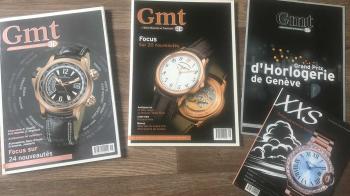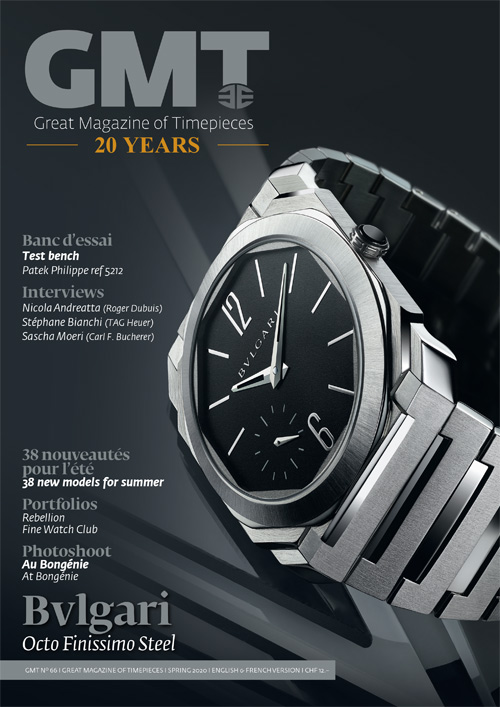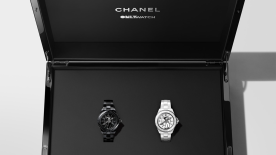In 2007, GMT Magazine took a decisive step in its development, with its founders Brice Lechevalier and Pierre Jacques accepting the offer of takeover from the Edipresse Group, which also acquired the website WorldTempus and the Grand Prix d’Horlogerie de Genève at the same time. In the same vein, GMT produced the official GPHG catalogue for the first time and then included it in the distribution of its autumn edition. The magazine’s power of attraction extends beyond the boundaries of watchmaking, appealing to those who simply love beautiful things from all over the world.
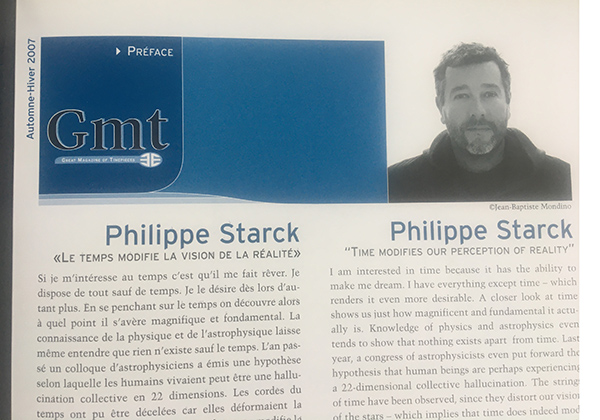
Thus, in the preface of GMT’s spring 2007 issue, Philippe Starck defended the theory that time “changes the vision of reality”. He continued: “It is therefore an extraordinary value, charged with poetry and romanticism”. The same year, it was the president of the Monaco Yacht Show and founder of Only Watch, Luc Pettavino, who quoted Pythagoras in his preface of a GMT issue: “A man is never so great as when he is on his knees helping a child”. Then, Only Watch was on its second edition, where he brought together 35 brands to each create unique pieces for his organisation—the auction that year brought in CHF 2.75 million.
That year, Omega celebrated the 50th anniversary of the Speedmaster, Audemars Piguet celebrated Alinghi’s second success in the America’s Cup, Jaeger-LeCoultre inaugurated in Le Sentier its Heritage Gallery, whose curved glass wall rises 4.7 meters and contains 300 in-house calibres, and DeWitt cut the ribbon for its Manufacture, which covers over 1,500m2.
Chronographs change status
Clearly, you father’s standard chronograph was surpassed, with this change reflected in the heightened competition between watch brands of all sizes. More content, more shapes, more water-resistance, more diameters, more functions—the arms race is in full swing. A global media playground in this era, the America’s Cup sees the challengers and their sponsors compete against each other. Attracted by the rising sun, TAG Heuer supported China Team and dedicated a limited series of 500 pieces of its Calibre S Chronograph with regatta countdown, both in quartz and mechanical versions. Hublot dresses its Big Bang in the colours of Luna Rossa and presents alongside it a Big Bang Gold Mat chronograph in microblasted red gold. Girard-Perregaux sees things in a big way with a chronograph with regatta countdown and R&D 01 perpetual calendar for its American challenger BMW Oracle Racing. Alinghi won the bet with its Royal Oak Offshore Alinghi Team chronograph, which once again brought the America’s Cup to Switzerland. With the wind in its sails, the same collection was also available in Shaquille O’Neal limited series (960 pieces) in steel or white gold with a set bezel, and Arnold’s All-Stars in rose gold (350 pieces).
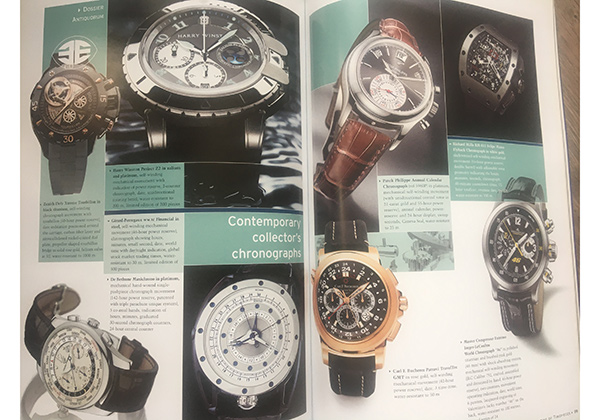
Staying in the theme of the seas, Jaeger-LeCoultre offered a very masculine Master Compressor Diving Chronograph, while Zenith charged the dose of testosterone with its Defy Xtreme Open El Primero Chronograph in titanium and pink gold, water-resistant to 1000m. Following its own course, Rolex designed a new chronograph calibre for its Oyster Perpetual Yacht Master II, and Chopard has also chosen the chronograph to celebrate 10 years of its Manufacture in Fleurier, through the new GT3 calibre equipping its Chrono One. Even Piaget has produced a chronograph version of its Polo with a second 24-hour time zone. The watchmaking content is being strengthened at Montblanc, which acquired Minerva in 2006 and created the Institute for Research in Fine Watchmaking, whose first steps were symbolised in the Grand Chronographe Authentique in white gold (47mm) with the Minerva 16-29 calibre. In another field, François-Paul Journe designed the Centigraphe Souverain, which theoretically enabled a speed of 360,000km/h to be measured with its counter at 10 o’clock equipped with a lightning seconds (1 revolution per second) with a scale to the 100th, for which two patents relate to the chronograph mechanism.
Distinguished in 2007
Among the leading figures of contemporary haute horlogerie, De Bethune became one of the most important centres of innovation in 5 years, establishing itself in particular as the first brand to have developed and used silicon balance springs. In addition, its watchmaking founder Denis Flageollet patented a terminal curve improving isochronism and limiting deformation due to shocks. Energy and the quest for efficiency have also led to the development of a barrel with ruby bearings, aimed at improving the friction of the spring leaves and eliminating sticking due to excess grease. Even the comfort of the case shows innovation through a pivoting stretcher system whose modular curvature adapts perfectly to each wrist. Richard Mille also pursued his high-tech quest with the RM 012, whose tubular construction of the movement and dial in stainless steel alloy remains breath-taking. Bovet’s strong and authentic identity reinforces its legitimacy with a tourbillon minute repeater featuring inverted hands on a black gold-powdered movement, thanks to a process it has developed: the blackened movement is visible on the reverse side of the watch face. On another register altogether, Romain Jérome launched its Titanic DNA and gave new life to the Titanic with a collection of watches incorporating steel from the most famous liner in the world, even going so far as to put rust at the heart of its watches. Meanwhile, the Chanel ship continued its journey by unveiling the J12 GMT, still a success today.
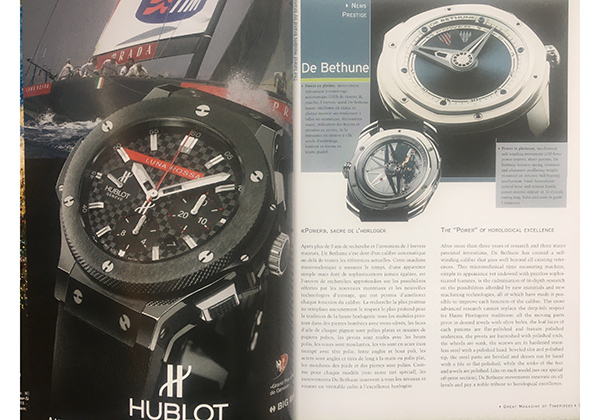
The zeitgeist of the time displayed in interviews
In the pages of GMT, CEOs lend themselves to verbal jousting that reflected increasingly tense issues. For Richard Mille, who had just launched his RM 016, which is as rectangular as it is flat: “After a long period of very wise leadership, watchmaking has recently entered a messy phase, to be frank. I’m not complaining because in a way I’ve modestly contributed to paving the way. However, a lot of people have since jumped on the bandwagon, and this is only viable if everyone contributes their share of creativity. We must not fall into the trap of copying others. If I take the example of my friend François-Paul Journe, he was able to innovate enormously and obtain a watch that is immediately identifiable although it retains a classic style. I’m not giving lessons but each brand has to find its own style.” The same went for Georges-Henri Meylan: “If the Swiss watch industry wants to maintain its level of success, it has to be creative in terms of products and not just repeat trends that work in the moment.”
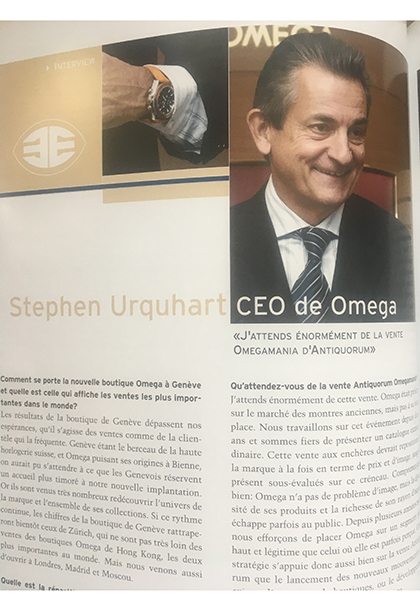
For Fawaz Gruosi, “Today consumers are changing watches as much as they change their shirt”, to which Stephen Urquhart replied: “For many, the watch has become a cult object. This is also why I would be more concerned that its perception could become blurred by offering many options. Too many brands and too much promise could damage its image. It is dangerous to take advantage of the current economic health to sell anything at any price.” Commenting on Omega, he said: “We have been working for two years on the Antiquorum Omegamania auction, which I have high expectations of, and which should help to reposition Omega in terms of price and image. Omega does not have an image problem, but the diversity of its products and the richness of its range sometimes escapes the public’s notice. For several years we have been trying to place Omega in a higher and more legitimate segment than the one in which it is sometimes perceived”. Would the final word go to Richard Mille, who stated that “we live in a profession which sets the time but is always late”?
Next week: watchmaking in 2008.
*To celebrate its 20th anniversary in 2020, GMT Magazine will summarise weekly, exclusively on WorldTempus, the essence of its content published year after year in the last 20 years. The information is by no means exhaustive and refers to excerpts. For a more in-depth view of the last two decades of watchmaking, order The Millennium Watch Book produced by GMT Magazine and WorldTempus with the contribution of over twenty experts, each of whom witnessed this incomparable period in our industry.
WorldTempus offers below the Spring 2020 GMT for download.
